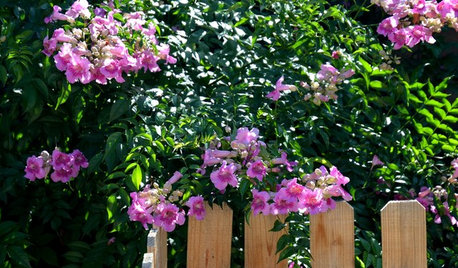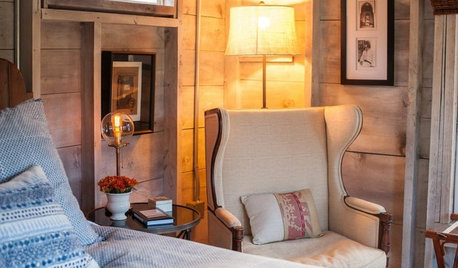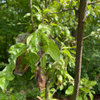training my hardy kiwi (pic)
semaje
14 years ago
Related Stories

MOST POPULAR50 Shades of Gray
Gray is hotter than ever, thanks to a hit novel full of risks and dark secrets. Tell us: Which paint shade possesses you?
Full Story
EDIBLE GARDENSHow to Grow 10 Favorite Fruit Trees at Home
Plant a mini orchard in fall, winter or early spring to enjoy fresh-off-the-tree fruit the following year
Full Story
EDIBLE GARDENSWhy Grow Quince? For Beauty, Fragrance and Old-Time Flavor
Delightfully perfumed fruit and lovely spring blossoms make this apple and pear cousin worth a spot in the garden
Full Story
HOUZZ TOURSMy Houzz: Elegant Updates for a 1928 Bungalow
Classic, clean furnishings and creamy hues bring charm and ease to a Texas couple's home
Full Story
PINK FLOWERSGreat Design Plant: Pink Trumpet Vine Heralds Vibrant Color
Announce your landscape beautification efforts with this flowering vine that perks up hot, dry gardens
Full Story
GARDENING GUIDES8 Native Shrubs for Year-Round Bird Feeding
It’s not just about berries. These plants provide insects for birds and seasonal interest for gardeners
Full Story
ROOM OF THE DAYRoom of the Day: A Maine Guest Cottage Steeped in Charm
Once offering eggs for sale, this little guesthouse now offers a serene experience in a refined rustic setting
Full Story
WINTER GARDENINGPruning Secrets for Exquisite Roses
Encourage gorgeous blooms year after year with this time-tested advice on how to prune your rosebush in winter for health and shape
Full Story
GREEN BUILDINGHouzz Tour: See a Concrete House With a $0 Energy Bill
Passive House principles and universal design elements result in a home that’ll work efficiently for the long haul
Full Story
SAVING WATERHouzz Call: Are You Letting Go of Your Lawn?
Many facing a drought are swapping turf for less thirsty plantings. If you’re one of them, we’d like to hear about it
Full StoryMore Discussions








kiwinut
ejp3
Related Professionals
Sahuarita Landscape Architects & Landscape Designers · Wakefield Landscape Contractors · Concord Landscape Contractors · Concord Landscape Contractors · East Lake-Orient Park Landscape Contractors · Framingham Landscape Contractors · Hurricane Landscape Contractors · Lehigh Acres Landscape Contractors · Little Ferry Landscape Contractors · Lynn Landscape Contractors · Mashpee Landscape Contractors · Saint John Landscape Contractors · Severna Park Landscape Contractors · Thonotosassa Landscape Contractors · Raytown Landscape ContractorsScott F Smith
semajeOriginal Author
alexander3_gw
semajeOriginal Author
alexander3_gw
Ann
semajeOriginal Author
alan haigh
logrock
ocbeachbum
davidwv
davidwv
logrock
alan haigh
semajeOriginal Author
cindy-6b/7a VA
semajeOriginal Author
logrock
alan haigh
semajeOriginal Author
davidwv
alan haigh
logrock
semajeOriginal Author
semajeOriginal Author
logrock
semajeOriginal Author
logrock
semajeOriginal Author
logrock
semajeOriginal Author
logrock
davidwv
semajeOriginal Author
semajeOriginal Author
semajeOriginal Author
logrock